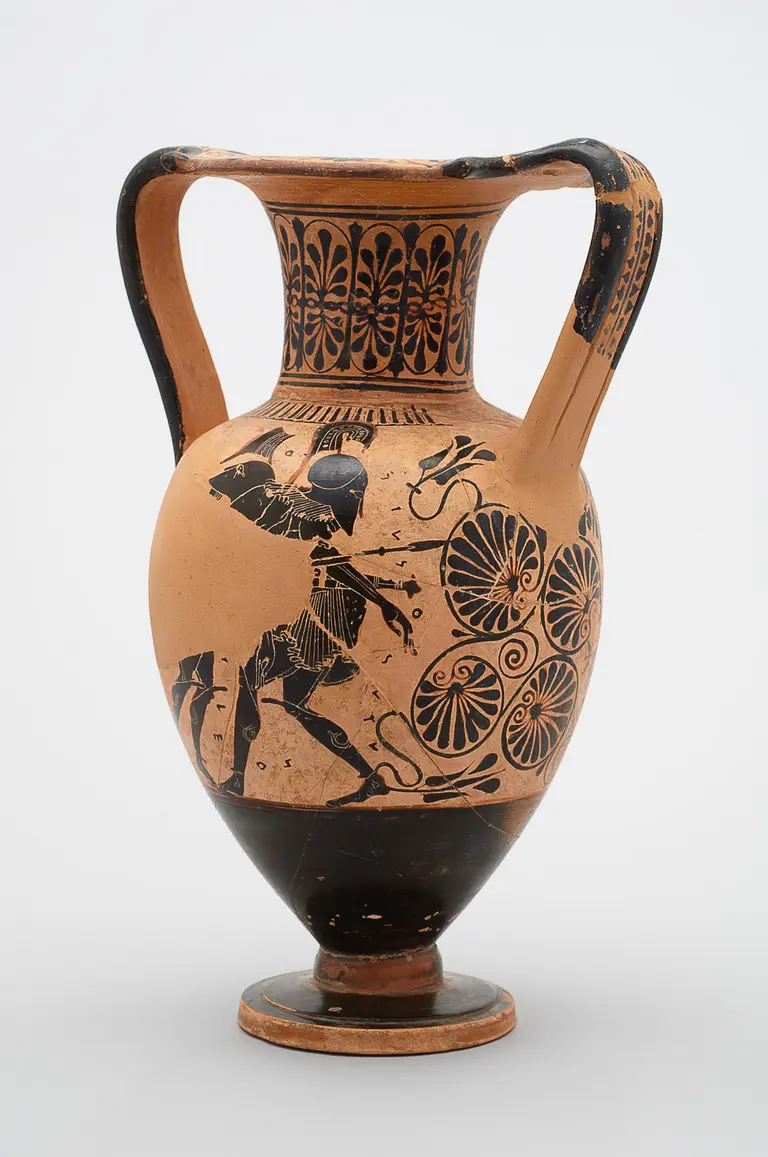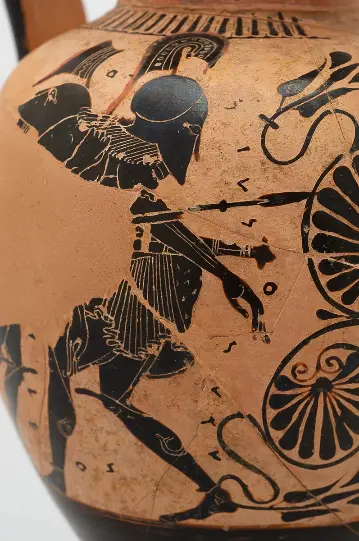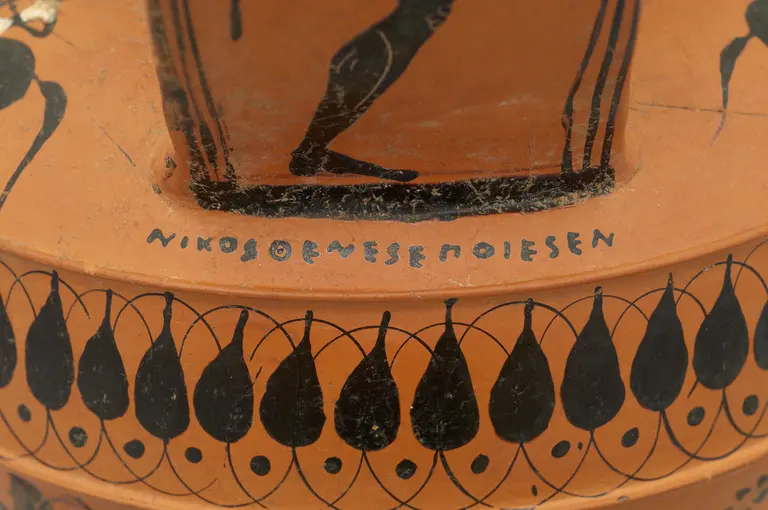When we think about Greek inscriptions, we perhaps have the image before our eyes of large-scale texts chiselled in stone. They can, however, appear quite differently as well: we find them on Greek vases, lightly (or also somewhat more starkly) incised into the upper surface, or applied with a brush in spirited fashion. Some of these clearly stand out from the background, while others are scarcely recognisable, indistinctly written, or are located in hidden places.
A distinction is made between painted and incised inscriptions. Incised inscriptions were generally applied to the pot after firing, and have almost nothing to do with the representations on the vessels. In addition to owner’s inscriptions or gift dedications, a great variety of markings or notations are also included. Even customer orders are noted here!
In contrast, painted inscriptions were always made at the same time as the vase’s pictorial decoration and are therefore part of the overall concept. Here, particular categories of inscriptions were developed in particular in the production centres in and around Athens (Attic vase painting). They extend from inscriptions that explain the pictorial image, signatures with the names of workshop owner, potter, or vase painter (women are almost never attested), up to inscriptions that reproduce the sound of speaking – similar to speech bubbles in comics today.
Address
Collection of Greek and Roman Antiquities, Hochparterre
Maria-Theresien-Platz, 1010 Vienna
Google Maps
Opening times
Open Daily, 10 a.m. – 6 p.m.
Thu, 10 a.m. - 9 p.m.
On average, visitors spend around 1.5 hours in the Collection of Greek and Roman Antiquities.
![[Translate to English:] Bandhenkelamphora, um 530 v. Chr., griechisch. Kunsthistorisches Museum in Wien](/fileadmin/_processed_/2/8/csm_Bandhenkelamphora_3b567b6b76.webp)
The potter and workshop owner Nikosthenes proudly caused the product from his factory to be signed:
’Nikosthenes epoíesen’ ‘Nikosthenes made [it]’
Nikosthenes was the owner of the most productive pottery workshop in Athens in the second half of the 6th century BC.
Within the context of Vitrine EXTRA #7, we would like to show you some examples from this large number, and at the same time not avoid addressing the many questions that are connected with these inscriptions. In two special vitrines we invite you to a – possibly unusual – view of the underside of vessels, and to this end we have turned the vases almost upside down: in this way, you can see on the one hand markings and notations made by ancient merchants, and on the other hand marks which were made by the potter during production.
Further themes are also addressed in a total of seven additional stations in the same gallery. Here we turn our attention to the development of the Greek alphabet and point to name inscriptions, signatures, or the so-called kalos inscriptions (from the Greek kalós = ‘beautiful’) which are found on Greek vases from the permanent exhibit. Precisely this last group poses more questions than can be answered: they praise the beauty of Athenian youths and sometimes also young women – but what was their purpose? The numerous inscriptions that make no linguistic sense (‘nonsense inscriptions’) are also enigmatic. How can these be explained? Was the vase painter illiterate, or did he use templates which he supplemented based on his own imagination? Or did the symbols have only a decorative function? Finally, you can also see modern markings on the base of the vases: in red (or on a pink label) the current inventory number is recorded, often next to numbers made by an earlier owner of the vase.
It is not necessary to be able to read ancient Greek when you view the exhibition – the Greek texts have been transcribed and translated. All interested viewers are therefore whole-heartedly invited to take a dive with us into Vitrine EXTRA #7 and into the world of inscriptions on Greek vases, inscriptions which perhaps at first sight are inconspicuous, yet for that reason even more fascinating!


© KHM-Museumsverband
The inscriptions next to the figures
The figures are only ostensibly provided with inscriptions: ‘[Ach]i-le-os’ (at the left), ‘o’ (at the top), ‘s-iy-s-o-syty’ (at the right). The name of the hero Achilles can be surmised, but the individual character at the top and the sequence of letters at the right don’t make sense at all.
Imperial Impressions on the floor plan
Imperial Impressions is located on the second floor.
- 0
- 0
- 0
- 0
- 0
- 0
- 0
- 0
- 0
- 0
- 0
- 0
- 0
As part of the special presentation Vitrine EXTRA, various antique objects are presented temporarily in the permanent exhibition of the Collection of Greek and Roman Antiquities of the Kunsthistorisches Museum at regular intervals.
The Collection of Greek and Roman Antiquities showcases around 2,500 unique objects spanning 3,000 years, including treasure hoards, exquisite cameos, mosaics, and marble masterpieces that bring to life the history of ancient Greece, the Roman Empire, and their neighboring cultures.

![Detailansicht von Inv.-Nr. IV 3605: Unterhalb eines der beiden Henkel, ist die Signatur des Töpfers Nikosthenes zu lesen („Nikosthenes epoíesen“ – „Nikosthenes hat [es] gemacht“)](/fileadmin/_processed_/1/f/csm_Detailansicht_von_Inv.-Nr._IV_3605_2260fe6a3f.webp)